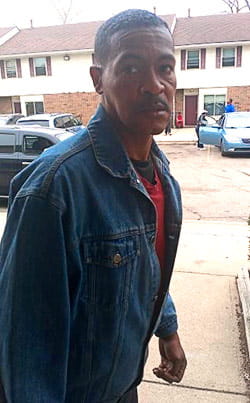Novel Council at UH Harrington Heart & Vascular Institute Diverts Patients from Amputation
March 24, 2022

Maurice Edwards of Cleveland knew he might lose his leg to amputation. He had poor circulation accompanied by moderate to severe pain. He lived with the pain, but one day in 2019, while riding the bus home from work, he couldn’t ignore it anymore.
“I couldn’t really sit down. I kept moving around because it was so painful,” he said.
When he got home, he took off his shoes and his foot was cold to the touch. His leg was dying.
Edwards’ case was so severe that he was scheduled for amputation. But thanks to a novel council at University Hospitals (UH) Harrington Heart & Vascular Institute, he was spared that fate.
Clinical decisions approving amputation are frequently made in isolation by the patient’s individual caregivers. Before a care team resorts to amputation, every patient deserves at least a second and even a third attempt at revascularization to save the leg. To address this problem, UH Harrington Heart & Vascular Institute created a novel system-wide interdisciplinary team called the Limb Salvage Advisory Council (LSAC).
“Circulation issues often cause painful cramping, numbness and wounds which can greatly decrease a person’s quality of life. When a doctor suggests amputation to address the pain, patients usually follow that recommendation, yet nearly half of all people with vascular disease will die within five years of an amputation. This is higher than the five-year mortality rates for breast cancer, colon cancer and prostate cancer,” said Mehdi Shishehbor, DO, MPH, PhD, President of UH Harrington Heart & Vascular Institute, and Angela and James Hambrick Chair in Innovation.
The LSAC includes vascular surgeons, endovascular interventionalists, vascular medicine specialists, podiatrists, and wound care experts. Once a patient who is scheduled for a major amputation is identified, the treating physician may elect to notify a designated coordinator who arranges for an urgent virtual LSAC meeting. LSAC members review and discuss available data including comorbidities, functional status, extent of tissue loss, relevant imaging studies and prior interventions with the goal of providing diversified thoughtful inputs. Eventually, the LSAC reaches one of two conclusions: the limb is salvageable and a plan is created to save it, or the patient is approved to proceed with the originally scheduled amputation.
The LSAC evaluated Edwards’ case and decided upon a course of action to attempt to save his leg. It was successful.
Heart disease runs in Edwards’ family. His father, Maurice Edwards, Sr., died from the condition at the age of 43. Edwards is now 61 and has both legs and all 10 toes intact. He’s grateful the procedure has enabled him to continue to work, although he still lives with some aches and pains.
“Maurice’s condition was very poor. His leg was dying and he was, in fact, scheduled for an amputation. But we created LSAC at UH to help patients like Maurice. Our team worked together to create a plan to save his leg, which was successful. It’s a great honor to help patients like Maurice. Everyone deserves a dedicated team of clinicians working in their best interest and we’re proud to provide that here at UH,” said Dr. Shishehbor.
“I’m okay now,” he said. “I’m used to my legs being numb sometimes and aching sometimes, but they’re still warm and have blood flowing. I thank God and I thank Dr. Shishehbor.”
Cleveland’s National Public Radio station ideastream covered Maurice’s story and the LSAC program.
Click here to listen to Maurice’s story.
Click here to listen to an extended interview with Dr. Mehdi Shishehbor about limb salvage. (This segment starts at 27 minutes in the timeline.)


